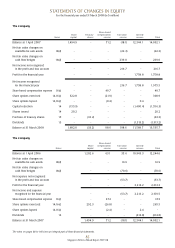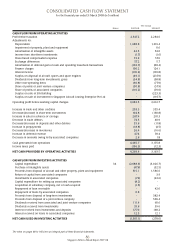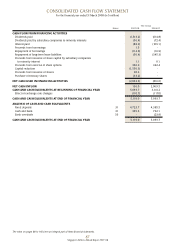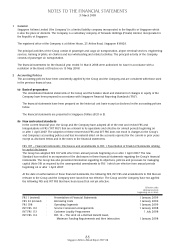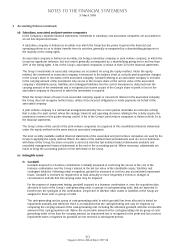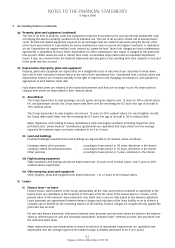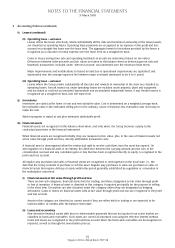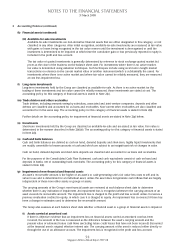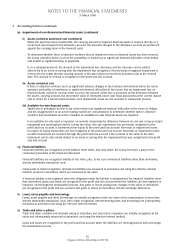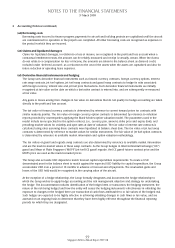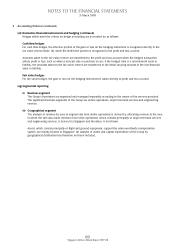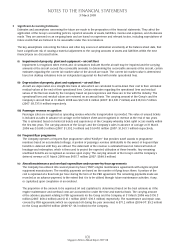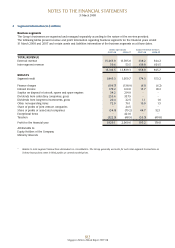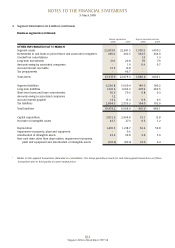Singapore Airlines 2008 Annual Report Download - page 96
Download and view the complete annual report
Please find page 96 of the 2008 Singapore Airlines annual report below. You can navigate through the pages in the report by either clicking on the pages listed below, or by using the keyword search tool below to find specific information within the annual report.Singapore Airlines Annual Report 2007-08
94
2 Accounting Policies (continued)
(k) Financial assets (continued)
(iii) Available-for-sale investments
Available-for-sale investments are non-derivative financial assets that are either designated in this category, or not
classified in any other categories. After initial recognition, available-for-sale investments are measured at fair value
with gains or losses being recognised in the fair value reserve until the investment is derecognised or until the
investment is determined to be impaired at which time the cumulative gain or loss previously reported in equity is
included in the profit and loss account.
The fair value of quoted investments is generally determined by reference to stock exchange quoted market bid
prices at the close of the business on the balance sheet date. For investments where there is no active market,
fair value is determined using valuation techniques. Such techniques include using recent arm’s length market
transactions or reference to the current market value of another instrument (which is substantially the same). For
investments where there is no active market and where fair value cannot be reliably measured, they are measured
at cost less impairment loss.
(l) Long-term investments
Long-term investments held by the Group are classified as available-for-sale. As there is no active market for the
trading of these investments and fair value cannot be reliably measured, these investments are stated at cost. The
accounting policy for this category of financial assets is stated in Note 2(k).
(m) Trade debtors and other receivables
Trade debtors, including amounts owing by subsidiary, associated and joint venture companies, deposits and other
debtors are classified and accounted for as loans and receivables. Non-current other receivables are also classified and
accounted for in the same way. The accounting policy for this category of financial assets is stated in Note 2(k).
Further details on the accounting policy for impairment of financial assets are stated in Note 2(p) below.
(n) Investments
Short-term investments held by the Group are classified as available-for-sale and are stated at fair value. Fair value is
determined in the manner described in Note 2(k)(iii). The accounting policy for this category of financial assets is stated
in Note 2(k).
(o) Cash and bank balances
Cash and bank balances are defined as cash on hand, demand deposits and short-term, highly liquid investments that
are readily convertible to known amounts of cash and which are subject to an insignificant risk of changes in value.
Cash on hand, demand deposits and short-term deposits are classified and accounted for as loans and receivables.
For the purposes of the Consolidated Cash Flow Statement, cash and cash equivalents consist of cash on hand and
deposits in banks, net of outstanding bank overdrafts. The accounting policy for this category of financial assets is
stated in Note 2(k).
(p) Impairment of non-financial and financial assets
An asset’s recoverable amount is the higher of an asset’s or cash-generating unit’s fair value less costs to sell and its
value in use and is determined for an individual asset, unless the asset does not generate cash inflows that are largely
independent of those from other assets or groups of assets.
The carrying amounts of the Group’s non-financial assets are reviewed at each balance sheet date to determine
whether there is any indication of impairment. An impairment loss is recognised whenever the carrying amount of an
asset exceeds its recoverable amount. The impairment loss is charged to the profit and loss account unless it reverses a
previous revaluation credited to equity, in which case it is charged to equity. An impairment loss is reversed if there has
been a change in estimates used to determine the recoverable amount.
The Group also assesses at each balance sheet date whether a financial asset or a group of financial assets is impaired.
(i) Assets carried at amortised cost
If there is objective evidence that an impairment loss on financial assets carried at amortised cost has been
incurred, the amount of the loss is measured as the difference between the asset’s carrying amount and the
present value of estimated future cash flows (excluding future credit losses that have not been incurred) discounted
at the financial asset’s original effective interest rate. The carrying amount of the asset is reduced either directly or
through the use of an allowance account. The impairment loss is recognised in the profit and loss account.
NOTES TO THE FINANCIAL STATEMENTS
31 March 2008



